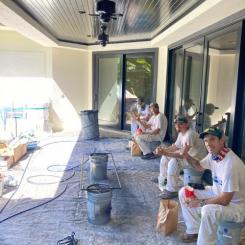Disposable Respirator Choices
8 July, 2022
8 July, 2022

By now, we’re probably all familiar with N95 disposable respirators. In fact, I’m sure most of you have N95’s readily available in your arsenal of safety products. But did you know there are many variations of an N95 with different features and benefits? Or even that there are ratings other than N95? This article will help explain what types of options are out there for you when it comes to choosing a disposable respirator.
The Seal of a Respirator To Your Face: First and foremost, a reason there are so many different disposable respirators is due to the variety of environments they are used in and the people using them: You want to find a respirator that fits you well and provides a secure seal to your face. If there’s one thing to take away from this article, it’s that the seal of the respirator is one of the most important factors when wearing a respirator. If you don’t have an effective seal, you likely will inhale an increase in contaminants from the air that passes around the edges of the respirator rather than the air that goes through the respirator filter media. It is unlikely that one respirator model will fit every individual, which is why there are so many different sizes and shapes of disposable respirators out there. To help ensure a disposable respirator is forming a tight seal to your face, you must go through a fit test at least once a year and perform a user seal check before each use. If you’re not getting a good seal with your current respirator, go out and try some others. And remember one more thing: You need to be clean shaven when wearing a tight-fitting respirator. Even a 5 o’clock shadow could interfere with the seal.
Comfort: So let’s say you find a respirator that provides a good seal, however it’s not comfortable. This could be a problem. If the respirator is not very comfortable, you may be tempted to adjust it (which could break the seal) or even take it off completely while in a contaminated area. Obviously, this isn’t how a respirator is intended to be used, so make sure to try different respirators to see which one provides the most comfort while providing a good seal to your face.
Breathability: The ability to breathe easily while wearing a disposable respirator is obviously a desirable feature. As you can imagine, if it’s not easy to breathe through, it’s going to be taxing to wear over time. That’s why, based on construction and design, some respirators are easier to breathe through than others, so keep that in mind when looking for a disposable respirator for your next job.
Exhalation Valves: If you have ever felt that wearing a disposable respirator during physically demanding work is uncomfortable, you may benefit from a disposable respirator with an exhalation valve. These one-way valves are located on the front of the respirator and only open when a user exhales. This helps release the warm, moist exhaled breath quickly from inside the respirator, which can allow for a more comfortable experience.
Carbon Layer: Let’s face it: some jobsites have odors. While disposable respirators are designed for filtering particulates, it’d be great if they could also reduce some of those smells. Well, it just so happens that some can. These types of disposable respirators have a layer of carbon embedded between the inner and outer shell of the respirator media and are great for helping to reduce nuisance levels of organic vapors or acid gases (look on packaging to see what they are designed for). Remember though that these are only good for nuisance levels of chemicals, which is defined as anything below the Occupational Exposure Limit (OEL). Anything above that needs a different type of respirator with chemicals cartridges such as a reusable half face respirator.
Straps/Headbands: Not all straps and headbands are created equal. Some are made of rubber, some are elastic, and some even have adjustability to help provide a secure seal. Each one has its pros and cons, but you may want to try out different styles to see which you prefer.
Noseclips: Noseclips are a very important feature since they can affect the seal as well as the comfort on your nose. If the noseclip isn’t very strong or doesn’t hold its shape very well, you may not be able to get and maintain a good seal around your nose. This could lead to inhalation of particles that travel through any such gaps and potentially fogging of safety glasses. Some noseclips can cause unwanted pressure on the bridge of your nose, creating discomfort over time. Take a look around to see what’s out there as there are different shapes and styles of noseclips.
Nosefoam: As mentioned above, the seal and comfort over the nose is critical. Some models of disposable respirators have nosefoam which can help with comfort as well as the seal to the user’s face. There are many different styles, from thick or thin to short or long, and even different materials or nothing at all.
Foam Faceseal: Some disposable respirators have a foam faceseal along the inside edge of the facepiece. This may help provide an effective seal for some people and may even provide enhanced user comfort and increased wearability.
Flatfold Disposable Respirators: Did you know disposable respirators come in different styles other than cupshaped? “Flatfold” respirators, for one example, have many benefits, including that they’re more convenient to transport and store since they are packaged flat and won’t get crushed like cup-style respirators could. If you’ve never heard of or seen these before, take a look for them. You may find your new favorite disposable respirator!
Additional NIOSH-Approved Disposable Respirator Categories: Lastly, there are many other disposable respirator ratings out there besides N95. In fact, there are 8 more. These are based on the NIOSH testing and rating system for particulate filters. There are three letters and three numbers - creating a grid of 9 ratings. These are: N, R, and P, and 95, 99, and 100. The letters refer to the filter’s ability to filter oil-based particulates, and the numbers represent the filtering efficiency. N means the filter is not resistant to oil-based particulates. R is somewhat resistant, and P is strongly resistant. 95 means it filters at least 95% of airborne particles, 99 is at least 99%, and 100 is at least 99.97%. That means an N95 has at least 95% filtration efficiency against certain non-oil-based particles, while a P100 has at least 99.97% filtration efficiency against certain non-oil and oil-based particulate contaminants.
Conclusion: As you can see, there are many types of disposable respirators out there with different features and benefits. Try different ones and see which model you prefer. APC
Jason Lunn is a 3M Application Engineer Specialist of Safety Products




Add new comment